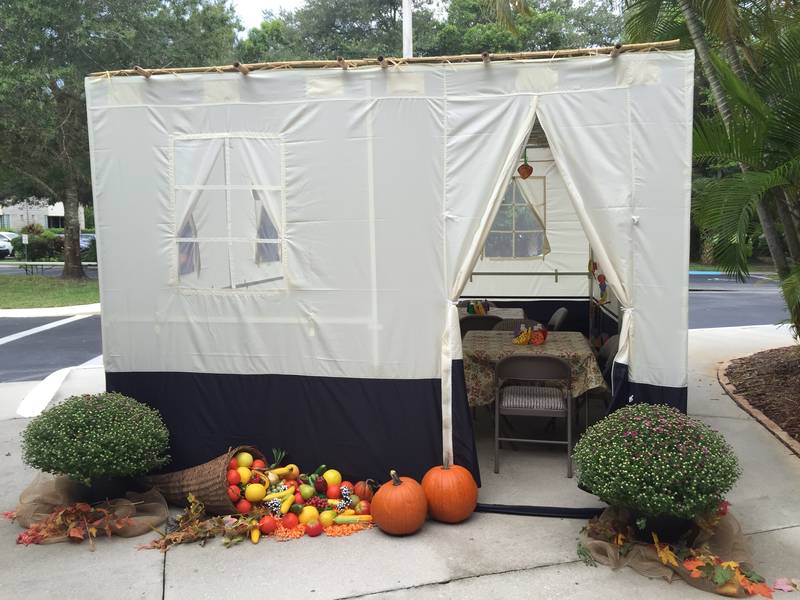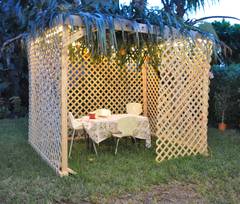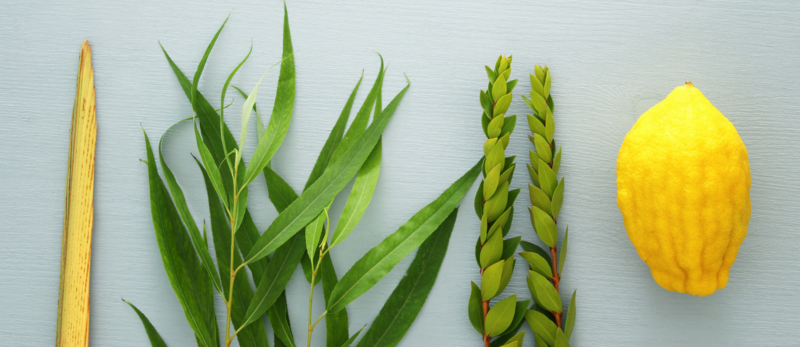Sukkot is one of the Jewish calendar's most joyous holidays. Sukkot is a Hebrew term that means "booths" or "huts" and refers to the Jewish celebration of giving thanks for the fall harvest. The holiday also commemorates the 40 years of Jewish wandering in the desert after the offering of the Torah atop Mt. Sinai.
 Sukkot, also known as Z'man Simchateinu (Season of Our Rejoicing), is the only holiday with a clear commandment to rejoice. Sukkot is observed on the 15th of the Hebrew month of Tishrei, five days after Yom Kippur, and is characterized by many unique rituals. One interpretation of the commandment to dwell in booths is to build a sukkah, a small, temporary booth or hut.
Sukkot, also known as Z'man Simchateinu (Season of Our Rejoicing), is the only holiday with a clear commandment to rejoice. Sukkot is observed on the 15th of the Hebrew month of Tishrei, five days after Yom Kippur, and is characterized by many unique rituals. One interpretation of the commandment to dwell in booths is to build a sukkah, a small, temporary booth or hut.
Sukkot have open walls and open doors, and this encourages us to welcome as many people as we can. We invite family, friends, neighbors, and community to rejoice, eat, and share what we have with each other.
Another name for Sukkot is Chag HaAsif (Festival of the Ingathering), representing the importance in Jewish life of giving thanks for the bounty of the earth.
CELEBRATE AT TEMPLE SHALOM
Unless otherwise noted, all services take place at Temple Shalom.
Livestreaming will be available for all services held in the Sanctuary.
First Day of Sukkot (October 17, 2024)
Service: 10:00 am
Our Temple Shalom sukkah is open outside the main entrance to the building throughout the Sukkot festival. You may come to fulfill the mitzvah of sitting in a sukkah.
Lulav and Etrog
Sukkot celebrates the fall harvest, expressed by blessing and waving the lulav and the etrog, symbols of the harvest; by building and decorating a sukkah; and by extending hospitality to friends and family.
The lulav is a combination of date palm, willow and myrtle branches, held together by a woven palm branch. The etrog, or citron, is a lemon-like fruit with a wonderful citrus smell. When reciting the blessing over the lulav and etrog, one should wave them in six directions—north, south, east, west, up, and down. This action symbolizes that God can be found in all directions, not only in one particular place.
Holiday Blessings

It is a mitzvah to celebrate in the sukkah. While the Torah instructs us to live in the sukkah for seven days, many choose to only eat meals in the sukkah. When eating or reciting kiddush in the sukkah, recite this blessing:
בָּרוּךְ אַתָּה, יְיָ אֱלֹהֵֽינוּ, מֶֽלֶךְ הָעוֹלָם,אֲשֶׁר קִדְּשָֽׁנוּ בְּמִצְוֹתָיו וְצִוָּֽנוּ לֵישֵׁב בַּסֻּכָּה
Baruch atah, Adonai Eloheinu, Melech haolam,
asher kid'shanu b'mitzvotav v'tzivanu leisheiv basukkah.
Blessed are You, Adonai our God, Sovereign of all: who hallows us with , commanding us to dwell in the .
The is held up in the right hand, and the is held pitom end (pointy side) down in the left hand. Facing east, recite the blessing. Then turn the etrog up and shake the entire bundle three times in each of six directions: straight ahead, right, back, left, up, and down.
בָּרוּךְ אַתָּה, יְיָ אֱלֹהֵֽינוּ, מֶֽלֶךְ הָעוֹלָם, אֲשֶׁר קִדְּשָֽׁנוּ בְּמִצְוֹתָיו וְצִוָּֽנוּ עַל נְטִילַת לוּלָב
Baruch atah, Adonai Eloheinu, Melech haolam,
asher kid'shanu b'mitzvotav v'tzivanu al n'tilat lulav.
Blessed are You, Adonai our God, Sovereign of all, who hallows us with mitzvot, commanding us to take up the lulav.
The first time you wave the lulav each year, recite the blessing marking a special occasion:
בָּרוּךְ אַתָּה, יְיָ אֱלֹהֵינוּ, מֶלֶךְ הָעוֹלָם, שֶׁהֶחֱיָנוּ וְקִיְּמָנוּ וְהִגִּיעָנוּ לַזְּמַן הַזֶּה
Baruch atah, Adonai Eloheinu, Melech haolam,
shehechehyanu, v'kiy'manu, v'higianu laz'man hazeh.
Blessed are You, Adonai our God, Sovereign of all who, has kept us alive, sustained us, and brought us to this season.
You can download a printable version of the Sukkot blessings here.
celebrate at HOME
Sukkot is one of the most fun holidays to celebrate at home. There's nothing like having your own Sukkah and using it at mealtimes or even overnight to camp out!

Build a Sukkah
The sukkah symbolizes the frail huts in which the Israelites lived during their 40 years of wandering in the desert after the Exodus from Egypt. It also serves to remind Jews of the biblical account of how God protected them, provided for their needs in the wilderness, and by implication, still watches over us today.
Sukkot come in many variations, but there are some guidelines to follow when building them. Two important ones are:
- A sukkah has to have two and a half walls. Only one can be an existing wall, like the side of a house. The walls may be constructed of any material, generally canvas, wood or metal. Today, it is possible to buy ready-to-assemble sukkah kits.
- The roof is to be temporary, covered with loose branches from trees or anything that grows out of the ground, and has been cut off from the ground. According to tradition, this roof covering, s’chach, should give shade and yet allow those in the sukkah to see the stars through the roof at night.
Once the sukkah is built, it is common to decorate it by hanging fruit and other items from the s’chach, putting posters on the walls, and even laying carpet on the floor.







